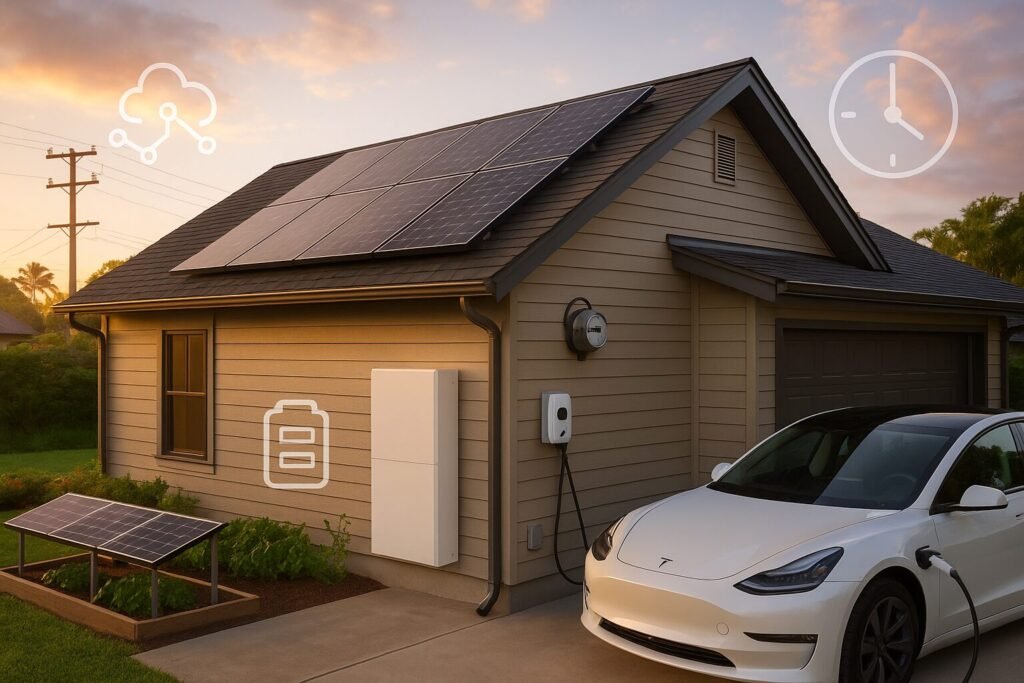The Future of Solar: What’s Next by 2030
Panels, batteries, rates, VPPs, and permits—see what’s changing in solar over the next 5 years and how to plan a smart, resilient system.
Hi, I’m Crazy Old Prepper. I live small, tinker constantly, and I’m building a micro homestead one practical project at a time. Here’s what I’m watching in solar over the next five years—and how I’d plan a system today so it still feels smart in 2030.
TL;DR Snapshot (Skimmers start here)
- Panels: You’ll see more back-contact / heterojunction / TOPCon first; perovskite tandems will appear in niche retail SKUs, then spread. Expect modest, real-world efficiency bumps on rooftops before major leaps.
- Prices: Hardware keeps trending down long-term, but soft costs (labor, permitting, interconnection) and tariff/supply swings can whipsaw quotes.
- Batteries: LFP (and variants) rule for safety + cycle life; faster installs and clearer throughput warranties.
- Policy: More net billing and time-of-use → batteries move from “nice” to “often worth it.”
- Blackouts: Typical homes land around 10–30 kWh storage with 7–15 kW PV if backup matters.
- VPPs: Virtual power plants expand; payouts depend on your utility + event frequency.
- Permitting: “Instant” approvals spread where AHJs adopt standardized checks.
- End-of-life: Better recycling / take-back programs nudge purchase decisions.
- New use cases: Agrivoltaics, balcony kits, and smarter microinverters open doors for small spaces and small farms.
Skim-Stopper: Buy Now or Wait?
If your roof is ready, rates are moving to TOU/net billing, and you want blackout resilience, buying now with battery-ready wiring (or a modest starter battery) usually beats waiting for the “next big panel.” If your roof is tight on space, it can be worth waiting for higher-efficiency modules—but I’d still pre-wire.
1) What New Panel Tech Actually Reaches Homes?
I love reading lab headlines, but I plan purchases around what installers can get, warrant, and service.
What’s real between now and 2030
- Back-contact / HJT / TOPCon continue to replace older PERC: slightly higher module efficiency, better temperature coefficients, and lower degradation.
- Perovskite-silicon tandems: pilot lines and early retail models appear first in premium ranges; ramp depends on durability, encapsulation, and bankability.
- Bifacial on rooftops: helps in high-albedo settings (white roofs, bright ground), less so over dark shingles.
Roof-reality vs. datasheets
- Nameplate jumps don’t always equal kWh gains after you factor tilt, azimuth, shading, soiling, wiring, inverter clipping, and performance ratio.
- Expect incremental roof output gains first; bigger leaps arrive as tandems mature.
Buyer checklist
- Bankability + warranty (product + performance).
- Degradation rate and temperature coefficient.
- Weight, dimensions, and mounting for your racking.
- Inverter/microinverter matching with higher-power modules.
2) Will Solar Prices Fall—or Whipsaw?
I’ve seen quotes drop on modules, only to bounce from tariffs, freight, or factory ramps.
What drives today’s price
- Hardware: modules, racking, wiring, inverters, optimizers.
- Soft costs: design, permitting, inspections, labor, overhead (these often dominate).
What pushes up or down
- Trade actions & tariffs, shipping costs, polysilicon cycles, and U.S. manufacturing build-outs.
- Local labor markets and AHJ requirements can swing bids more than module prices.
Practical moves
- Get multiple quotes within a 2–3-week window.
- Ask for price-hold windows and clarify escalation clauses.
- Lock interconnection steps early to avoid delays.
3) Batteries: Safer, Longer-Lived, Easier to Install
I favor LFP for home storage: stable, predictable, widely supported.
Chemistry & form-factor trends
- LFP / LFP-plus dominate for safety and cycle life.
- Modular cabinets and pre-wired enclosures shorten install time and clean up the look.
What to compare
- Round-trip efficiency, continuous/peak power, depth-of-discharge, and usable kWh.
- Throughput warranty (total MWh over life), not just years.
- DC-coupled vs AC-coupled: DC can be more efficient in solar-charging paths; AC is easier to retrofit.
Buy now vs wait
- If you have TOU rates or frequent outages, consider buying now.
- If you’re purely chasing export arbitrage, wait to see your utility’s net billing math.
4) Net Metering → Net Billing + TOU: Do Batteries Become Essential?
We’re seeing a steady move from classic net metering to net billing with time-variant export values.
What that means for your bill
- Daytime exports may be worth less; evening peak power costs more.
- A battery lets you shift solar from low-value hours to peak hours.
Sizing rules of thumb
- Daily bill shaving: size for 3–5 hours of evening peak loads.
- Resilience + bills: split capacity—reserve 20–30% for outages; use the rest for TOU.
5) Blackout Readiness: Typical Solar + Battery Sizes by 2030
I plan for critical loads first (fridge, lights, internet, a few outlets), then decide if whole-home is worth it.
Typical pairings I expect to keep seeing
- 7–15 kW PV with 10–30 kWh storage for most homes wanting a day of resilience + TOU shifting.
- Multi-day coverage needs load management, conservative thermostat settings, and sometimes a generator hybrid.
Step-by-step
- List critical loads and watts.
- Decide hours of coverage (8–24+).
- Calculate usable kWh (account for DoD and reserve).
- Check inverter power for motor starts (soft-start helps).
6) Will Virtual Power Plants (VPPs) Actually Pay?
VPPs stitch together thousands of home batteries to help the grid.
How it works
- You opt in; the aggregator schedules limited dispatch windows.
- You get credits for capacity and/or energy delivered during events.
What matters to a homeowner
- Payout structure: $/kW-month, event payments, or bill credits.
- Cycling impact: confirm warranty allowances for third-party dispatch.
- Opt-out controls: can you set reserve for your own backup?
7) Permitting & Interconnection: From Weeks to “Instant”
I’m excited about standardized plan sets and automated checks.
Faster paths
- Jurisdictions adopting instant permits for standard rooftop designs.
- Utilities offering online interconnection portals, clear smart-inverter settings, and pre-approved equipment lists.
Your action list
- Ask installers if they use standardized plan sets eligible for same-day approval.
- Confirm interconnection timelines before you sign.
8) Incentives: What’s Likely, What’s Sunsetting
Policy changes, but a few patterns help planning.
Baseline to know
- The federal ITC covers qualified solar + storage; storage eligibility is now broader.
- State / utility adders come and go: battery rebates, performance-based incentives, and low-income carve-outs.
Planning moves
- Time your paperwork: claim in the year the system is placed in service.
- Track basis reductions for certain rebates.
- If you’re a business, consider depreciation and bonus incentives.
For details, start here: 2025 Solar Incentives & Tax Credits Guide.
9) Smarts Everywhere: Inverters, EV Chargers, V2H/V2G
The home is becoming an energy orchestra.
Device roles
- Smart inverters manage grid ride-through and volt/VAR.
- Load controllers and smart panels shape when big loads run.
- EVSE integrates charging with solar and rates; bidirectional units add V2H/V2G potential.
Design patterns I like
- A critical-loads subpanel for clean backup.
- Whole-home transfer only if you size for it (or accept managed loads).
- Leave space in the main panel for future EV + battery expansion.

10) End-of-Life: Recycling, Reuse, and Warranties
End-of-life rules are tightening, which is good for the ecosystem.
What to watch
- Take-back programs from manufacturers and regional recyclers.
- Clarify product vs performance warranty, RMA process, and transferability if you sell the home.
Buy with the end in mind
- Favor bankable brands, transparent recycling partners, and clear support channels.
11) New Use Cases: Agrivoltaics, Balcony Kits, Micro-Inverters
Small spaces and small farms get real options.
Agrivoltaics
- Elevated racking for shade-tolerant crops, fencing for animal safety, and careful row spacing for equipment access.
Balcony / plug-in kits
- Great for renters/condos where allowed. Check utility rules, rapid-shutdown compliance, and GFCI details.
- Expect modest yield—nice bill trim, not whole-home power.
Micro-inverter / optimizer roadmap
- Higher per-module power ratings, robust rapid-shutdown, cleaner module-level monitoring, and better salt-mist/wind certifications for coastal roofs.
Mini-Calculators (Quick Math You Can Do)
Battery value under TOU(kWh shifted to peak each day) × (peak – off-peak rate) × (days/month)
Blackout coverage estimate(Critical-load watts × hours needed) ÷ (usable kWh) → sanity-check your size
Simple Flowchart: Buy Now vs Wait
- Tight roof space? → Consider waiting for higher-efficiency modules or use premium-efficiency now.
- Rates moving to TOU/net billing? → Add a battery or at least battery-ready wiring.
- Frequent outages? → Prioritize backup now; consider V2H-capable EVSE later.
- Slow permitting in your area? → Choose an installer with standardized plan sets and clear interconnection playbook.
Installer Checklist
- Module tech: TOPCon/HJT/back-contact? Warranty (product + performance)?
- Battery: Usable kWh, throughput warranty, round-trip efficiency, continuous/peak power.
- Inverter: Smart functions, rapid shutdown, EVSE integration.
- VPP eligibility: Payouts, cycling policy, opt-out.
- Paperwork: Permit timeline, interconnection steps, incentive forms.
